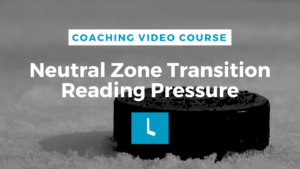(Transcribed from How to Play Hockey: Our Minor Hockey Coaching Course.)
Gap control is a term so critical in hockey. The “gap” is the space between an attacking forward and the defender.
In open ice we want our gap control to be around a couple of stick lengths, where as in smaller spaces its maybe the reach of one stick. The wider the gap, the bigger the gap, the more options the attacker has and the less pressure they feel, then they can really attack against the defender.
[maxbutton id=”2″ ]
As a defender if you have backed up too far you tend to stop moving your feet and slow down. All the while you have an attacker coming down on you at top speed. When this happens the defense has basically no chance and the attacker is going to blow right by you.
We want to have our D staying close, staying equal distance and matching the speed of the attacking FWD and it’s much harder for this FWD to have success on the one on one.
Gap Control is based largely around the D getting up in the play. So if the puck is on the far blue line and the D is on the near blue line when this turnover happens that D is in trouble so the D needs to constantly get up with the play and pivot to the middle forcing opposing players to take it wide.
I like to use the analogy of seaweed in the water. As the play comes up the D goes up. As the turnover happens the D comes back. Too often especially young or novice D get caught standing still watching the play and as this gap widens it’s going to cause them problems later in that sequence.
Fundamental at every level of hockey, but very common at the younger levels is usually the D doesn’t have the confidence to get up or the knowledge to get up in the play. It’s the same talked about even at the highest levels where the D are always focusing on needing to get up with the play. So they do drills and practice where the D really has to work rather than coast.
See you in the next video!
Looking to download half ice hockey practice plans, goalie drills for teams (not a goalie coach?!) or small area games drills? We’ve got you covered too. Click here. Perfect for recreational level coaches.





